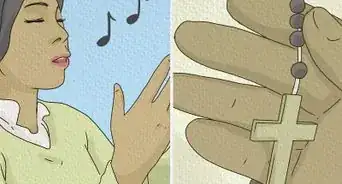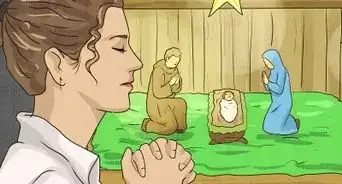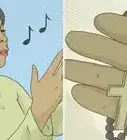This article was co-authored by Zachary Rainey. Rev. Zachary B. Rainey is an ordained minister with over 40 years of ministry and pastoral practice, including over 10 years as a hospice chaplain. He is a graduate of Northpoint Bible College and a member of the General Council of the Assemblies of God.
This article has been viewed 107,108 times.
Between the egg hunts and chocolates, it’s easy to overlook the real meaning of Easter. Talking to your kids about Jesus’ life and incorporating your faith into your Easter traditions will help children understand what Easter is all about. Reassuring them about Jesus’ love will also help them feel comforted rather than frightened by the Easter story.
Steps
Introducing the Religious Meaning of Easter
-
1Tell the story of Easter in your own words. Think about your child’s age and the concepts that make sense to them. Tell the Easter story using words that they already know in a way that makes sense for their age level.
- You might say to a young child under 10, “Do you know the reason we celebrate Easter? It’s because Jesus gave us a very special gift. Do you know how sometimes, even when we try our best not to, we fight or argue? Jesus went to heaven early so God could forgive us, even when we don’t do our best.”
- To a child over 10, you might say, “Do you know why Easter is so important to me? It reminds me that Jesus loves me. People on earth in Jesus’ time did not recognize how good Jesus was. They actually punished him, even though he was perfect. He accepted that punishment and died. Easter is the celebration of when Jesus rose from the dead to be with God. He gave his life so we could always ask God to forgive us when we fall short of his example.”
-
2Read the story of Easter together from a child-friendly bible. Use a children’s bible to share the story of Jesus’ crucifixion and resurrection with your child. Pause occasionally to allow your child to ask questions and to explain any new concepts.[1]
- These bibles use words that are more accessible to children. You may find yourself enjoying the clear and simple language, too!
- Tailor any responses you give to your child’s questions to their age.
- Crucifixion is a scary concept even for adults. If a child asks, you might say, “Crucifixion was a kind of punishment for people who did bad things. Jesus wasn’t bad, but he endured the punishment because he loved all of us. He wanted us to always be able to ask God for forgiveness when we are not perfect.”
Advertisement -
3Connect your churchgoing to what you have read together in the bible. Help your child link the masses you attend with events from the story of Easter. Especially if you attend church multiple times over holy week, this can help your child understand the meaning behind the holiday.[2]
- You might say, “Remember, on Maundy Thursday we celebrate the day Jesus washed the disciples’ feet. He cared for them because he loved them, just like he loves you.”
- Point out any parts of the mass that reinforce the story of Easter. For example, at a Maundy Thursday service, the priest will often wash the feet of parishioners. You might say, “The priest is celebrating Jesus by doing the things that he did. Remember how we read that Jesus washed his disciples’ feet?”
-
4Send your kids to Sunday school or children’s mass for a clear lesson. Ask your church if there are any special Easter lessons for children. It can be helpful for children to hear about Jesus’ life and the Easter story from people who regularly teach the material to kids, such as priests and Sunday school instructors.[3]
- Some churches hold special masses around Easter and Christmas that are specifically geared towards children. These masses may tell the Easter story using puppets or have very simplified homilies that make Jesus’ life easier to grasp.
-
5Seek out children’s books that explain Easter. Go to your local bookstore and ask an associate to point you towards religious literature for kids. Just like you might spend an afternoon painting Easter eggs, spend a day reading child-friendly versions of the Easter story.
- “What is Easter” by Michelle Medlock Adams is a book for children under 5 that makes use of illustrations to explain the story of Jesus.
- If your kids like the Berenstain Bears books, pick up a copy of “The Berenstain Bears and the Easter Story” by Mike Berenstain. In the story, Papa Bear explains the story of Easter.
- You can order books online or look for a local Christian bookstore, if your normal bookstore doesn’t carry them.
Learning about Easter through Activities
-
1Make Easter baskets for other children. Teach your children the values Jesus lived by performing this Easter-themed act of service. Donate the Easter basket you’ve made to children in need, caring for them the way that Jesus cared for us.[4]
- You might say, “You know how Jesus loved us so much he gave his life for us? Let’s help other people feel special and cared for in the spirit of Jesus.”
- Your kids can write out lines of scripture on little pieces of paper and place them in plastic Easter eggs.
- Putting a children’s book about the meaning of Easter in the basket is a great way to share the religious joy of Easter with others.
-
2Decorate eggs with religious symbolism. Paint eggs with Christian symbols, such as crosses or doves, to focus on the meaning behind Easter while enjoying a nonreligious pastime. Children in middle school and older can paint symbols to tell the story of the crucifixion, such as a crown of thorns or a stone, for a meaningful project.[5]
- Suggest your child use color as a way to express emotions about Easter.
- An egg painted black could symbolize sadness at Jesus’ death, while happy, brightly colored eggs could symbolize joy at his resurrection.
-
3Give presents that represent new life. Give your children baby stuffed animals to represent new beginnings, such as baby chicks or piglets, in the spirit of Easter. You could even consider small, easy pets, such as a real goldfish, if your child is old enough for the responsibility.[6]
- When you give the gift, you might say, “Did you notice that this stuffed chick is just a baby? Jesus died so we could have a new life with God. I hope that when you squeeze this new little chick you think about the new beginning Jesus gave us.”
-
4Have a religious scavenger hunt. Hide everyday items that relate to the story of Easter—such as a sheet, a palm frond, a rock, or bread—for a scavenger hunt. Give each child an Easter basket to collect their scavenger hunt items. Talk about the significance of each item when you come together at the hunt’s end.
- To keep your kids engaged, perhaps reward them with a treat or sticker for every item they collect or every question they can answer correctly about Easter.
- Even though the scavenger items are not candy, try to make the spirit light and keep things fun.
Managing Children's Reactions to Strong Themes
-
1Focus on the positive aspects of Easter. Avoid going into too much detail about Christ’s death if your children are very young. You can best determine what’s age-appropriate for your child and their understanding. Focusing your lesson on Jesus’ ascension to heaven can keep things positive.[7]
- If your child is too young to understand death, you might say, “Jesus was punished even though he did nothing wrong, which was very sad. He put up with the punishment because he loved us. But the good news is, after his punishment he got to be with God, just like we will get to be with God some day.”
- For children over 5, you might opt for something direct but simple: "Jesus did die, and it was very sad. But it's okay because he came back to life." Then, talk over the details of the resurrection story.
-
2Let kids know it's okay to feel sad about Jesus’ death. Tell your children that it's okay to cry or feel sad, especially on the days of Easter weekend where you talk a lot about the death of Jesus. Remind them that feeling sad when you read or hear about sad things is normal. [8]
- While there’s no need for your child to suppress their emotions, it’s okay to keep things positive. You might say, "It's okay to be sad, but remember that Jesus died so we don't have to deal with this kind of pain alone. God loves us and is always with us."
- Alternatively you could say, “When I feel overwhelmed reading about the story of Easter, I remember how much hope and joy there is in the story. Can you imagine how elated Mary was to find out her son was resurrected and with God?”
-
3Encourage a focus on new beginnings as Easter ends. End Easter on a positive note by reminding your kids that anything is possible through Jesus’ love for them. The next year, your children will be eager to celebrate the holiday and embrace its religious meaning in a new way.[9]
- Keep your children engaged and interested in the meaning behind Easter by looking towards the future. You might say, “I loved teaching you more about the story of Jesus this year. How should we celebrate him on Easter next year?”
Expert Q&A
-
QuestionHow do you explain Easter to small children?
 Zachary RaineyRev. Zachary B. Rainey is an ordained minister with over 40 years of ministry and pastoral practice, including over 10 years as a hospice chaplain. He is a graduate of Northpoint Bible College and a member of the General Council of the Assemblies of God.
Zachary RaineyRev. Zachary B. Rainey is an ordained minister with over 40 years of ministry and pastoral practice, including over 10 years as a hospice chaplain. He is a graduate of Northpoint Bible College and a member of the General Council of the Assemblies of God.
Ordained Minister Only provide age-appropriate information. Babies are born with no fear of fire or electricity, no appreciation of the arts, no language skills, no responsibilities, and no knowledge of God. In regards to Easter, it is enough that an infant or toddler receives loving care that reflects the unselfish love of God found in the meaning of the Easter story. As the child matures, add details from the Gospel narrative. This will provide greater understanding of the death and resurrection of Jesus Christ. Explain Jesus’ motive for such an unselfish love: Jesus gave His life to provide forgiveness, to break down the sinful barriers that people have placed between themselves and God, and to transform selfish people into a loving people.
Only provide age-appropriate information. Babies are born with no fear of fire or electricity, no appreciation of the arts, no language skills, no responsibilities, and no knowledge of God. In regards to Easter, it is enough that an infant or toddler receives loving care that reflects the unselfish love of God found in the meaning of the Easter story. As the child matures, add details from the Gospel narrative. This will provide greater understanding of the death and resurrection of Jesus Christ. Explain Jesus’ motive for such an unselfish love: Jesus gave His life to provide forgiveness, to break down the sinful barriers that people have placed between themselves and God, and to transform selfish people into a loving people. -
QuestionHow do I explain Easter to a kid that's 4 years old? He knows just a bit about Jesus, he doesn't goes to church.
 Community AnswerMake sure that he understands that things like candy, eggs, and the Easter bunny are not why we celebrate Easter, that Jesus's death, burial, and resurrection and the chance at eternal salvation is why we celebrate. One idea to reinforce this is to call it "Resurrection Sunday" instead of Easter, as this translates to real meaning.
Community AnswerMake sure that he understands that things like candy, eggs, and the Easter bunny are not why we celebrate Easter, that Jesus's death, burial, and resurrection and the chance at eternal salvation is why we celebrate. One idea to reinforce this is to call it "Resurrection Sunday" instead of Easter, as this translates to real meaning. -
QuestionWhere does Jesus live?
 Community AnswerRight now Jesus lives in heaven, but he is also with us here on Earth, watching over us and using the Holy Spirit to guide us in our lives.
Community AnswerRight now Jesus lives in heaven, but he is also with us here on Earth, watching over us and using the Holy Spirit to guide us in our lives.
Warnings
- Understand that learning about the crucifixion and resurrection can be frightening or confusing. Exercise patience with your child as you introduce difficult themes.⧼thumbs_response⧽
References
- ↑ http://www.whatchristianswanttoknow.com/teaching-kids-about-easter-5-great-ways/
- ↑ http://www.whatchristianswanttoknow.com/teaching-kids-about-easter-5-great-ways/
- ↑ https://mom.me/kids/6577-how-teach-kids-about-easter-without-terrifying-them/
- ↑ http://www1.cbn.com/mommy/archive/2011/04/18/celebrating-the-real-meaning-of-easter-with-your-kids
- ↑ http://www1.cbn.com/mommy/archive/2011/04/18/celebrating-the-real-meaning-of-easter-with-your-kids
- ↑ http://www1.cbn.com/mommy/archive/2011/04/18/celebrating-the-real-meaning-of-easter-with-your-kids
- ↑ https://mom.me/kids/6577-how-teach-kids-about-easter-without-terrifying-them/
- ↑ https://mom.me/kids/6577-how-teach-kids-about-easter-without-terrifying-them/
- ↑ http://www1.cbn.com/mommy/archive/2011/04/18/celebrating-the-real-meaning-of-easter-with-your-kids
About This Article
If you want to teach your children the real meaning of Easter, try telling them the story of Easter in your own words so it will make sense to them. You could start by saying something like, “Do you know why we celebrate Easter? It’s because Jesus gave us a very special gift.” Alternatively, you could read the story of Easter together in a children’s bible. Just make sure to pause occasionally so your child can ask questions and fully understand the story. Besides reading the Easter story, you can also reenact it to help your child learn the real meaning. For example, consider making Easter baskets with your child and then donating them to children in need to demonstrate the way that Jesus cared for the needy. To learn how to talk about difficult subjects, like crucifixion, with your child, read more from our Minister co-author.
-Step-1-Version-4.webp)
-Step-2-Version-3.webp)
-Step-3-Version-3.webp)
-Step-4-Version-3.webp)
-Step-5-Version-3.webp)
-Step-6-Version-3.webp)
-Step-7-Version-3.webp)
-Step-8-Version-3.webp)
-Step-9-Version-2.webp)
-Step-10-Version-2.webp)
-Step-11-Version-2.webp)
-Step-12-Version-2.webp)

-Step-8-Version-3.webp)

-Step-10.webp)



















-Step-8-Version-3.webp)

-Step-10.webp)


































